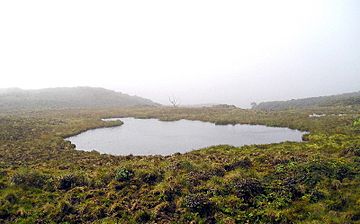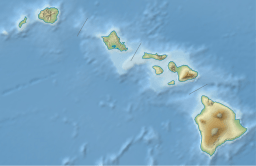Mount Waialeale facts for kids
Quick facts for kids Waiʻaleʻale |
|
|---|---|

Waiʻaleʻale (or 'Rippling Waters') Lake, the namesake of Mount Waiʻaleʻale.
|
|
| Highest point | |
| Elevation | 5,148 ft (1,569 m) |
| Geography | |
Mount Waiʻaleʻale is a famous mountain on the island of Kauaʻi in Hawaii. It is known for being one of the wettest places on Earth! The name Waiʻaleʻale means "rippling water" or "overflowing water." This makes perfect sense for such a rainy spot.
The mountain is a type of volcano called a shield volcano. It is the second-highest point on Kauaʻi. Mount Waiʻaleʻale stands about 5,148 feet (1,569 m) tall. Since 1912, it has averaged more than 373 inches (9,500 mm) of rain each year. In 1982, it even had a record 683 inches (17,300 mm) of rain!
Contents
Mount Waiʻaleʻale: Earth's Rainy Mountain
The top of Mount Waiʻaleʻale has a tropical rainforest climate. This means it gets a lot of rain all year long. Some reports say it rains on about 360 days each year!
Even though Waiʻaleʻale is very wet, some other places get even more rain. For example, Mawsynram and Cherrapunji in India get higher average rainfall. However, the rain at Waiʻaleʻale is spread out more evenly throughout the year. In India, most of the rain falls during the monsoon season.
| Climate data for Mount Waialeale | |||||||||||||
|---|---|---|---|---|---|---|---|---|---|---|---|---|---|
| Month | Jan | Feb | Mar | Apr | May | Jun | Jul | Aug | Sep | Oct | Nov | Dec | Year |
| Record high °F (°C) | 79.9 (26.6) |
81.2 (27.3) |
83.3 (28.5) |
79.6 (26.4) |
82.2 (27.9) |
81.8 (27.7) |
82.6 (28.1) |
83.1 (28.4) |
83.6 (28.7) |
83.4 (28.6) |
81.9 (27.7) |
81.1 (27.3) |
83.6 (28.7) |
| Mean daily maximum °F (°C) | 77.9 (25.5) |
77.7 (25.4) |
77.6 (25.3) |
78.2 (25.7) |
79.3 (26.3) |
80.5 (26.9) |
81.1 (27.3) |
81.7 (27.6) |
81.0 (27.2) |
78.9 (26.1) |
77.4 (25.2) |
79.0 (26.1) |
79.2 (26.2) |
| Daily mean °F (°C) | 69.8 (21.0) |
70.2 (21.2) |
70.5 (21.4) |
70.8 (21.6) |
71.6 (22.0) |
72.8 (22.7) |
74.0 (23.3) |
74.4 (23.6) |
74.6 (23.7) |
74.2 (23.4) |
72.6 (22.6) |
70.8 (21.6) |
72.2 (22.3) |
| Mean daily minimum °F (°C) | 61.7 (16.5) |
62.7 (17.1) |
63.4 (17.4) |
63.4 (17.4) |
63.9 (17.7) |
65.1 (18.4) |
66.9 (19.4) |
67.1 (19.5) |
68.2 (20.1) |
69.5 (20.8) |
67.8 (19.9) |
62.6 (17.0) |
65.2 (18.4) |
| Average rainfall inches (mm) | 24.78 (629) |
24.63 (626) |
27.24 (692) |
47.24 (1,200) |
28.34 (720) |
30.65 (779) |
35.87 (911) |
32.75 (832) |
24.14 (613) |
31.76 (807) |
36.33 (923) |
30.10 (765) |
373.83 (9,495) |
| Average rainy days | 20 | 17 | 20 | 26 | 27 | 27 | 29 | 29 | 27 | 27 | 21 | 21 | 289 |
| Source 1: NOAA | |||||||||||||
| Source 2: Weatherbase | |||||||||||||
Why So Much Rain?
Several things make Mount Waiʻaleʻale so rainy:
- Location: It is located in the northern part of the main Hawaiian Islands. This means it gets more rain from weather systems that come during the winter.
- Cloud Barrier: The mountain's peak is just below a special layer in the air called the "trade wind inversion layer." Clouds carried by the trade winds cannot rise above this layer.
- Funnel Effect: The summit has deep valleys on three sides. These valleys act like funnels, directing all the moisture-filled air right towards the mountain.
- Steep Cliffs: The mountain's steep cliffs force the moist air to rise very quickly. This rising air cools down fast, squeezing out almost all the moisture. This creates a lot of rain right over the peak.
Nature and Wildlife
The huge amount of rain in this area creates a very wet, boggy place called the Alakaʻi Wilderness Preserve. This preserve is a large boggy area. It is home to many rare and special plants. The ground is so wet that it is very hard to walk through the area, even on trails.
Some rare plants found only in this area are named after the mountain. These include Astelia waialealae, Melicope waialealae, and Dubautia waialealae. These plants are endemic, meaning they naturally grow nowhere else in the world.
Images for kids
See also
 In Spanish: Monte Waialeale para niños
In Spanish: Monte Waialeale para niños





